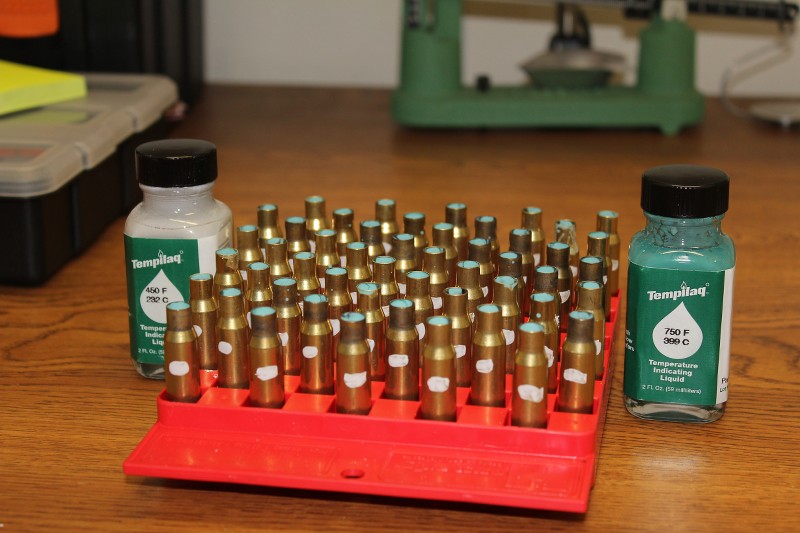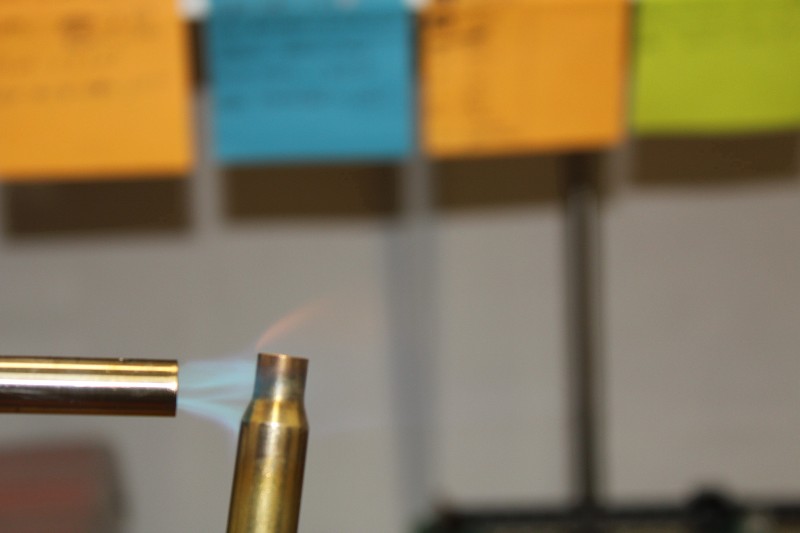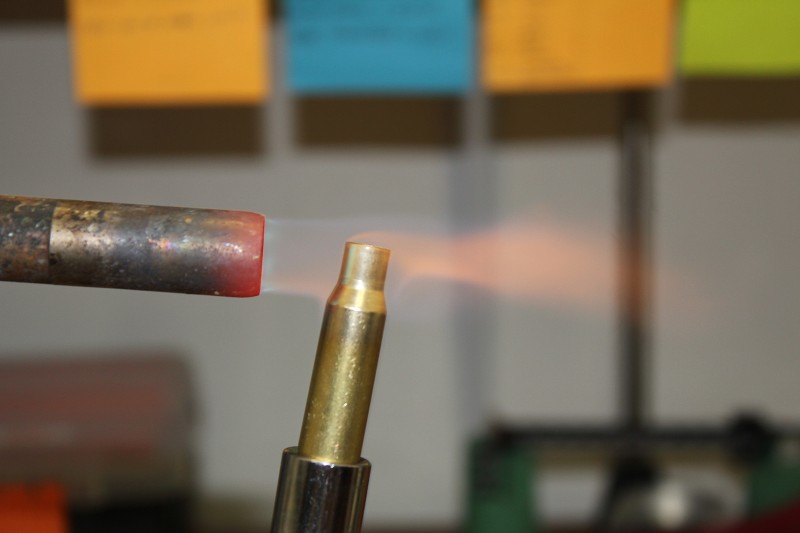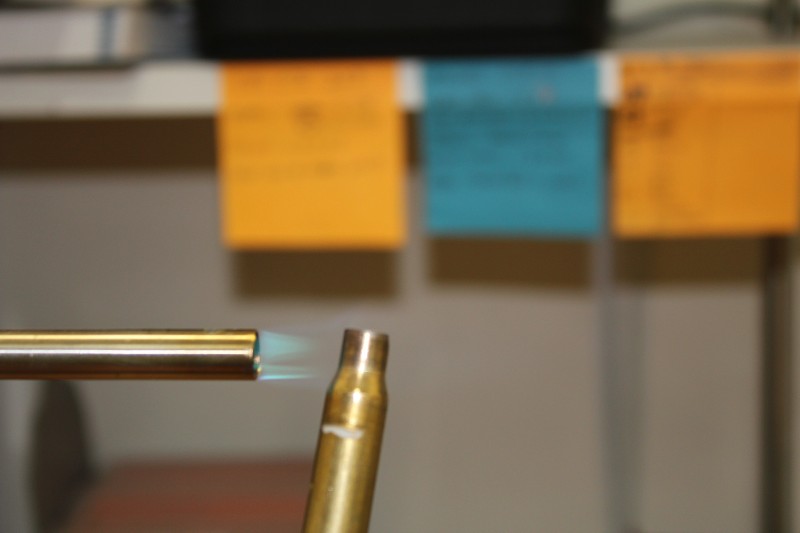I loaded up some old Hornet cases for my K Hornet and was surprised to find 43 of 44 cases cracked when I fired them for load development. I can only guess how many times I have loaded them I suspect it has been 10-12 times as hornet and K Hornet. Now the cases have only been neck sized since fire forming. Although I tried my hand in annealing before the last loading. I would not be surprised if the cases received too much heat. All the cracked cases were cracked in the area of the neck sizing. All cracks were vertical. That is suggesting to me that the necks were brittle. I thought the annealing would release tension on the necks and make them more flexible. So what do you think happened?
You are using an out of date browser. It may not display this or other websites correctly.
You should upgrade or use an alternative browser.
You should upgrade or use an alternative browser.
cracking necks
- Thread starter Longshot4
- Start date
43 of 44 cases cracked when I fired them for load development
From normal work hardening due to sizing and firing, I have never essentially all the cases fire in one cycle. With 43 of 44 cases cracking, there may be other factors in play. Exposure to ammonia called season cracking may be your problem.
If you use the water, You don't need to tip.
Try to solder a joint with water in it, its impossible as the heat dissipates too fast.
Longer cases do not require the water, 22 H-K may need it.
You may very well have waited too long.
As noted too hot just means too soft and not right characteristics but not crack.
do the next batch after 5-8 and it should extend a ways.
too little heat means they still crack, maybe a bit latter.
Annealing is a tough act to do right.
Try to solder a joint with water in it, its impossible as the heat dissipates too fast.
Longer cases do not require the water, 22 H-K may need it.
You may very well have waited too long.
As noted too hot just means too soft and not right characteristics but not crack.
do the next batch after 5-8 and it should extend a ways.
too little heat means they still crack, maybe a bit latter.
Annealing is a tough act to do right.
A lot of older books say "cherry red", which, depending on your local brand of cherries, can be a very dark red, barely enough to see it as red at all. They also used to stand the cases up in water 1/3 to 1/2 the way up to guard against over-softening the case heads (very, very bad), and tip the cases over to quench as soon as they were heated.
One of these days, I intend to buy a hand-held propane torch and have a go at some of my old .303 cases with the above method.
Controversy rages, and has previously done so, about all this but I agree that if it's towards the bright red-orange end of red, that's too much.
One of these days, I intend to buy a hand-held propane torch and have a go at some of my old .303 cases with the above method.
Controversy rages, and has previously done so, about all this but I agree that if it's towards the bright red-orange end of red, that's too much.
Correction it isn't 43 of 44 the correct number is 22 of 23. 3@12.5, 4@12.7, 4@12.9, 4@13.1, 4@13.2 and 4@ 13.3. All but one from 12.9gr. received cracks. I had been loosing a few cases do to cracks and that is what got me to anneal in the first place. I might not of annealed this group of cases do to them having primers in them when I was annealing. Although I don't have a record of witch Dies I used to size these particular loads. I have been neck sizing the K Hornet cases for many years with my RCBS Hornet FL dies. I recently purchased new Redding B FL 3V, NK P7 and ST P7 B set . I was looking at the remaining 21 of the 44 cases of that group of R-P cases that I didn't load yet and they show witness marks near the lower portion of the body of the cases that may suggest that I may of neck sized with the Redding B FL dies. I don't know for sure. Perhaps switching dies after so many loadings may of stressed out what was left of the cases.
Pathdoc: I take that back about the Hornet necking K Hornet. I checked and it won't work. It works for neck sizing a 222 with a 223 die. Since I have not kept complete records on what exactly went on with the K Hornet I simply cant say. The R-P cases must of just ran out of life. I went to the range today and shot some old WW cases that were FL sized with the new Redding FL dies and had no problems with necks cracking so I believe the R-P cases just had wore out. I will try to be more careful on the information I post. Thanks for your observation Pathdoc.
reloader28
New member
"Any red is bad."
Any red is NOT bad, its just a little softer than needed. Some people think that you should never attempt it without Templac whatever that garbage is. But handloaders have been doing for YEARS with excellent results. You can spend the money on it if you want, but its not necessary.
You cant actually neck size with a FL sizing die. Its called partial sizing.
I put 2-5 thin washers I made from roofing metal under the sizing dies and that raises it up enough to not really touch the case except the neck. You will only size about half the neck doing this, but thats plenty to hold the bullet. Really improves accuracy and case life.
Make sure you write down how many washers in each caliber you use so you can do the same next time.
Any red is NOT bad, its just a little softer than needed. Some people think that you should never attempt it without Templac whatever that garbage is. But handloaders have been doing for YEARS with excellent results. You can spend the money on it if you want, but its not necessary.
You cant actually neck size with a FL sizing die. Its called partial sizing.
I put 2-5 thin washers I made from roofing metal under the sizing dies and that raises it up enough to not really touch the case except the neck. You will only size about half the neck doing this, but thats plenty to hold the bullet. Really improves accuracy and case life.
Make sure you write down how many washers in each caliber you use so you can do the same next time.
reloader28: It would be partial neck sizing. I have used a friends 223 dies to prep my 222 cases they may of been a neck size die set that would make sense. In fact we were shooting baby aspirins at 100yds. My best friend and competitor was shooting his Ruger single shot 223. He sold that rifle the next day. He now shoots a 700 Remington just like mine. I was also able to seat the bullets with his 223 die set.
I may be missing a clever trick here, but how does one neck size with a full length die?
Cleaver? A trick? Can't be, I am neither cleaver or tricky. I use a feeler gage. I adjust the die off the shell holder with a feeler gage. I avoid sizing the complete cases with the die afjusted below the shell holder. What I have trouble doing is 'partial full length sizing'. With my dies, shell holders and presses the first part of the case to get sized is the neck, not all of it just some of it. Before the complete neck is sized the die contacts the case body, when that happens the shoulder is pushed forward before the shoulder of the case contacts the shoulder of the die. After that everyone tries to place there label on the process. I do not, I control the length of the case from the shoulder/datum to the head of the case.
I do all of this with a feeler gage that I did not discover, invent, nor did 'it' come to me in an apathy.
I am the fan of transfers, standards and verifying.
F. Guffey
The "rule of thumb" on neck sizing is that to hold the bullet properly, the sized portion of the neck should be at least 1/2 the caliber of the bullet. More doesn't seem to hurt anything, and may give more consistent results. Each gun seems to be a individual, and what gives you best performance in one, might be totally ignored by the next.
10-12 firings (annealed or not) is not bad performance, and Hornet brass is thin to begin with. Neck cracks mean the brass has been worked too much, and proper annealing can extend the life.
Head cracks mean too much brass has flowed forward, and the case life (all cases in that batch) is essentially over. Annealing will not help.
One method I know of, used by some friends who cast bullets is to dip the case necks in the lead pot. Holding the base in your fingers means you won't get too much heat reaching the case head. The people I know who use this method do it with rifle (2"+ case length) brass, and report satisfactory results. Might not be a good idea to do it with the short Hornet brass.
I think it likely your brass has just simply reached the end of its useful life...
(but I've been wrong before,.. )
)
Good Luck.
10-12 firings (annealed or not) is not bad performance, and Hornet brass is thin to begin with. Neck cracks mean the brass has been worked too much, and proper annealing can extend the life.
Head cracks mean too much brass has flowed forward, and the case life (all cases in that batch) is essentially over. Annealing will not help.
One method I know of, used by some friends who cast bullets is to dip the case necks in the lead pot. Holding the base in your fingers means you won't get too much heat reaching the case head. The people I know who use this method do it with rifle (2"+ case length) brass, and report satisfactory results. Might not be a good idea to do it with the short Hornet brass.
I think it likely your brass has just simply reached the end of its useful life...
(but I've been wrong before,..
Good Luck.
Jim Watson
New member
I think if I had gotten 10-12 cycles out of such a flimsy case as a Hornet, I would think its service life was over.
I don't know if you can salvage the unsplit ones by annealing but it won't take much to find out.
I don't know if you can salvage the unsplit ones by annealing but it won't take much to find out.
I've done a fare amount of annealing and a good amount of testing how to get a consistent result . I'll add I never tested heating the case till I could see it turn any shade of red . My reloading area is very well lit and there's no way I could see it .
That all being said as some of you have stated . If the neck gets to hot it will be softer then if it hits the perfect temp and if it does not get hot enough your just waisting your time .
In all three of those situations It's likely you would have a different bullet hold/neck tension with each .
Here is my issue with visual and tactile methods . When using your fingers to hold the case sure that could work but you would need at least one control sample with a temp indicator in order to know how hot it should feel to you . all hands and fingers are different do to how they are calloused and that will change from person to person what they feel .
Then there,s the visual , maybe many of you can see the perfect color that will give you the exact tempo each time but again I'd think you would still need a control sample to tell you what color indicates 750* inside the neck .
Here are some picks that show cases being heated to the exact same temp using temp indicator while rotating in a drill about 80rpm . These test were to figure out what would give the most consistent results by hand . Meaning heating each and every case to the same temp . By doing so keeping bullet hold and neck tension consistent . If your looking to just extend case life you can likely just wing it and be just fine .
If you are not turning the cases while heating . You will need two torches with the flames pointed at opposite side of the case . If you only heat one side of the neck the other side will never reach the same temp as the side with the flame on it .
Cases before test with temp indicator of 750* inside the necks and 450* just below the shoulder .All cases used in test were 308

These are what the flame looks like from a propane torch and a MAPP gas torch just as the the indicators melted
PROPANE

MAPP gas

Here is another propane heated case heated to the same temp as above and there is no orange/yellow flame because I adjusted the flame so it would not burn as hot . This shows just because you see or not see something . That does not mean your are at the temp needed .

If using the lower heat flame and heating the case till the flame turned orange/yellow the neck would have been over annealed . This is not to say visual annealing does not work because it does and is in fact how I do most of mine . I just start each session with a few control samples to get my timing and visual down .
How about this picture of three cases annealed to the same temp of 750* inside the neck . Only difference is where I held the flame on the case . As you can see the anneal marks are quite different from case to case even though they were heated to the same temp .

My point is just because you think know what your seeing does not mean your seeing what you think .
That all being said as some of you have stated . If the neck gets to hot it will be softer then if it hits the perfect temp and if it does not get hot enough your just waisting your time .
In all three of those situations It's likely you would have a different bullet hold/neck tension with each .
Here is my issue with visual and tactile methods . When using your fingers to hold the case sure that could work but you would need at least one control sample with a temp indicator in order to know how hot it should feel to you . all hands and fingers are different do to how they are calloused and that will change from person to person what they feel .
Then there,s the visual , maybe many of you can see the perfect color that will give you the exact tempo each time but again I'd think you would still need a control sample to tell you what color indicates 750* inside the neck .
Here are some picks that show cases being heated to the exact same temp using temp indicator while rotating in a drill about 80rpm . These test were to figure out what would give the most consistent results by hand . Meaning heating each and every case to the same temp . By doing so keeping bullet hold and neck tension consistent . If your looking to just extend case life you can likely just wing it and be just fine .
If you are not turning the cases while heating . You will need two torches with the flames pointed at opposite side of the case . If you only heat one side of the neck the other side will never reach the same temp as the side with the flame on it .
Cases before test with temp indicator of 750* inside the necks and 450* just below the shoulder .All cases used in test were 308

These are what the flame looks like from a propane torch and a MAPP gas torch just as the the indicators melted
PROPANE

MAPP gas

Here is another propane heated case heated to the same temp as above and there is no orange/yellow flame because I adjusted the flame so it would not burn as hot . This shows just because you see or not see something . That does not mean your are at the temp needed .

If using the lower heat flame and heating the case till the flame turned orange/yellow the neck would have been over annealed . This is not to say visual annealing does not work because it does and is in fact how I do most of mine . I just start each session with a few control samples to get my timing and visual down .
How about this picture of three cases annealed to the same temp of 750* inside the neck . Only difference is where I held the flame on the case . As you can see the anneal marks are quite different from case to case even though they were heated to the same temp .

My point is just because you think know what your seeing does not mean your seeing what you think .
Last edited:
My point is just because you think know what your seeing does not mean your seeing what you know .
That is the reason I make rules, I follow the rules and I use an annealing tool that that is based on 'the rules'.
F. Guffey
This past summer I tried for the first time to anneal all of my unloaded 222 and 22 K Hornet cases. It was the first time for me I did my home work and grabbed the materials that I had to try it. I used no temp indicator since I did not have any on hand. I can show the results of the process with cracked Hornet cases. So far the 222 cases seem to be in good form. My Grand Dauter shot a 5/8" 5 shot group with them last week. Yes Hornet are quite thin even compared to 222s. They also heat up very quick compared to the 222s. I used a cool burner with propane, case in a deep well socket, variable drill motor and a tray of water to drop cases into when I was satisfied with the color. No notes taken. That was it. F.Guffy I admire your ability to stick to physical details. Mr. Metal You show some fine details also.
